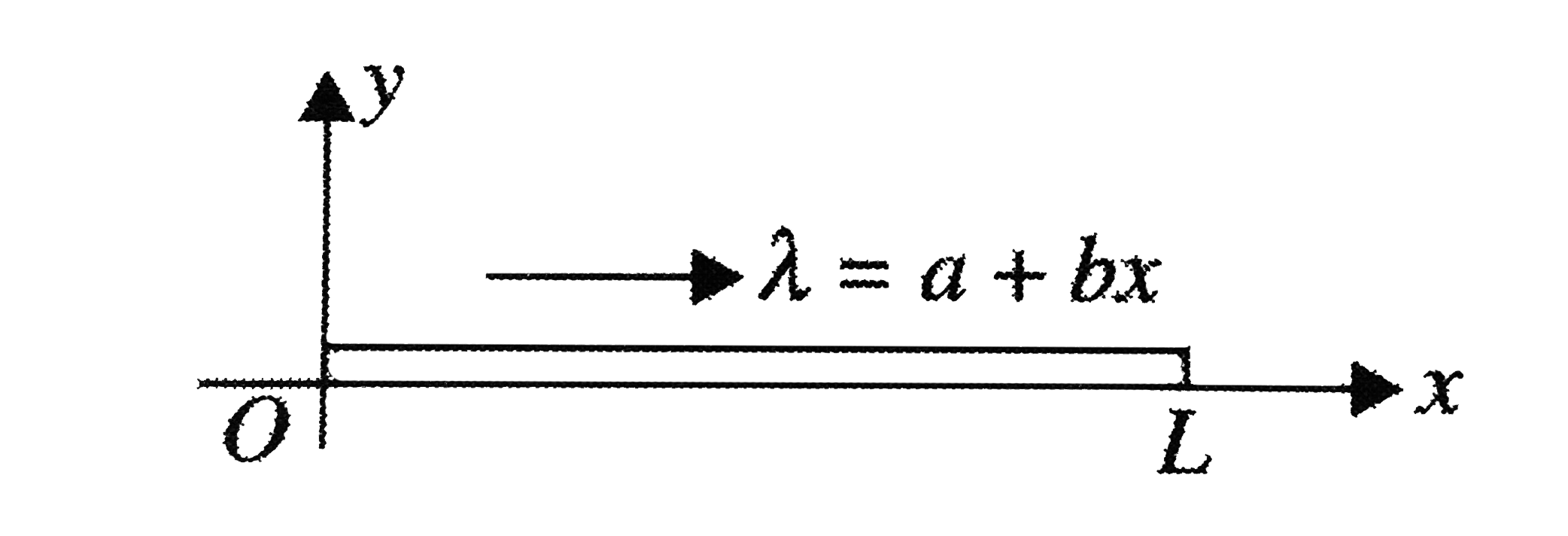Find centre of mass of given rod of linear mass density λ=(a+b(xl)2) , x is distance from one of its end. Length of the rod is l.
43(a+b2a+3b)L
32(a+b2a+b)L
32(2a+b3a+b)L
34(2a+b3a+b)L.
The correct Answer is:4
To find the center of mass of a rod with a given linear mass density λ=a+b(xl)2, where x is the distance from one end of the rod and l is the length of the rod, we can follow these steps:
1. Define the Linear Mass Density:
The linear mass density of the rod is given by:
λ(x)=a+b(xl)2
2. Express the Differential Mass Element:
The mass element dm can be expressed in terms of the linear mass density:
dm=λ(x)dx=(a+b(xl)2)dx
3. Total Mass of the Rod:
The total mass M of the rod can be calculated by integrating dm from 0 to l:
M=∫l0dm=∫l0(a+b(xl)2)dx
4. Calculate the Total Mass:
We can split the integral:
M=∫l0adx+∫l0b(xl)2dx
The first integral:
∫l0adx=a⋅l
The second integral:
∫l0b(xl)2dx=b(1l2)∫l0x2dx=b(1l2)⋅l33=bl3
Thus, the total mass M is:
M=al+bl3=l(a+b3)
5. Calculate the Center of Mass:
The center of mass xcm is given by:
xcm=1M∫l0xdm
Substituting dm:
xcm=1M∫l0x(a+b(xl)2)dx
This can be split into two integrals:
xcm=1M(∫l0axdx+∫l0b(x3l2)dx)
6. Calculate Each Integral:
The first integral:
∫l0axdx=a⋅l22
The second integral:
∫l0b(x3l2)dx=bl2⋅l44=bl24
Thus:
∫l0xdm=al22+bl24
7. Combine and Simplify:
Now substituting back into the center of mass formula:
xcm=1M(al22+bl24)
Substitute M:
xcm=1l(a+b3)(al22+bl24)
Simplifying gives:
xcm=la+b3(a2+b4)
8. Final Expression:
After simplifying the above expression, we find:
xcm=3l4⋅2a+b3a+b
Final Answer:
The center of mass of the rod is:
xcm=3l(2a+b)4(3a+b)
The linear mass density of the rod is given by:
λ(x)=a+b(xl)2
The mass element dm can be expressed in terms of the linear mass density:
dm=λ(x)dx=(a+b(xl)2)dx
The total mass M of the rod can be calculated by integrating dm from 0 to l:
M=∫l0dm=∫l0(a+b(xl)2)dx
We can split the integral:
M=∫l0adx+∫l0b(xl)2dx
The first integral:
∫l0adx=a⋅l
The second integral:
∫l0b(xl)2dx=b(1l2)∫l0x2dx=b(1l2)⋅l33=bl3
Thus, the total mass M is:
M=al+bl3=l(a+b3)
The center of mass xcm is given by:
xcm=1M∫l0xdm
Substituting dm:
xcm=1M∫l0x(a+b(xl)2)dx
This can be split into two integrals:
xcm=1M(∫l0axdx+∫l0b(x3l2)dx)
The first integral:
∫l0axdx=a⋅l22
The second integral:
∫l0b(x3l2)dx=bl2⋅l44=bl24
Thus:
∫l0xdm=al22+bl24
Now substituting back into the center of mass formula:
xcm=1M(al22+bl24)
Substitute M:
xcm=1l(a+b3)(al22+bl24)
Simplifying gives:
xcm=la+b3(a2+b4)
After simplifying the above expression, we find:
xcm=3l4⋅2a+b3a+b
The center of mass of the rod is:
xcm=3l(2a+b)4(3a+b)
Topper's Solved these Questions
Similar Questions
A rod length L and mass M is placed along the x-axis with one end at the origin, as shown in the figure above. The rod has linear mass density λ=2ML2x, where x is the distance from the origin. Which of the following gives the x-coordinate of the rod's center of mass?

View SolutionThe linear density of a thin rod of length 1m lies as λ=(1+2x), where x is the distance from its one end. Find the distance of its center of mass from this end.
View SolutionFind coordinates of mass center of a non-uniform rod of length L whose linear mass density lambda varies as lambda=a+bx, where x is the distance from the lighter end.
View SolutionThe centre of mass of a non-uniform rod of length L whose mass per unit length λ is proportional to x2, where x is distance from one end
View SolutionA heavy metallic rod of non-uniform mass distribution, is hanged vertically from a rigid support. The linear mass density varies as λ(x)=k×x where x is the distance measured along the length of rod, from its lower end. Find extension in rod due to its own weight.
View SolutionA non-uniform wire of length l and mass M has a variable linear mass density given by μ=kx, where x is distance from one end of wire and k is a constant. Find the time taken by a pulse starting at one end to reach the other end when the tension in the wire is T.
View SolutionA non–uniform thin rod of length L is placed along x-axis as such its one of ends at the origin. The linear mass density of rod is λ=λ0x. The distance of centre of mass of rod from the origin is :
View SolutionA uniform thin rod AB of length L has linear mass density μ(x)=a+bxL, where x is measured from A. If the CM of the rod lies at a distance of (712L) from A, then a and b are related as :_
View SolutionIf linear density of a rod of length 3m varies as λ=2+x, them the position of the centre of gravity of the rod is
View SolutionYou are given a rod of length L. The linear mass density is λ such that λ=a+bx. Here a and b are constants and the mass of the rod increases as x decreases. Find the mass of the rod

View Solution
